|
During his tenure - from Earle C. Anthony's time until after the station was sold to Cox Communications -. Newcomb saw many changes in the powerhouse station. He shares his memories with us. You can email Newcomb here |
|
During his tenure - from Earle C. Anthony's time until after the station was sold to Cox Communications -. Newcomb saw many changes in the powerhouse station. He shares his memories with us. You can email Newcomb here |
EARLE
C. ANTHONY’S FIRST CAR
The Story of His Birthday Record, its Label
and the Picture
After Mr. Anthony passed away, and KFI was sold, many things were changed. New things replaced old things. A12-inch acetate recording is one of the old things I saved. Many years have passed, yet when I slip this disk from its envelope, It is shiny black, not a fingerprint showing. It was a Presto blank recorded at KFI on December 18, 1950.
The red label; very large for a twelve-inch disk, is hand lettered: "BIRTHDAY GREETINGS TO EARLE C. ANTHONY - 33 1/3 RPM START OUTSIDE"
Staff members pasted up this special label. They cropped this photograph of a young (17 years old) Earle C. Anthony posed on his Electric Runabout. It was one of the gallery that filled the back wall of Mr. Anthony’s private office (I have seen it there.)
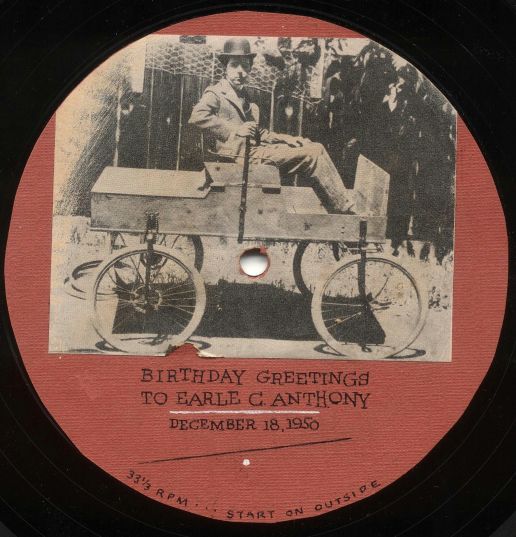
Allow me to point out parts of this old picture:
First, please ignore the center hole. Luckily, it does not puncture the car but allows the disk to be played. ECA assembled this electrified wagon as a young man and drove it on the LA streets.
This electric carriage is parked in front of an open shed. The noon sun shines down on Mr. Anthony as it keeps the shed in dark shadow. The bright spots of light are headlights. (Gas, auto headlights.) We can barely make out the outlines of wheels and fenders. This must have been the family garage; also, most probably, the site for the construction of this vehicle.
MECHANICAL ISSUES
Anthony has been having tire trouble. Two flat tires are on the ground by the rear wheel. The heavy load of batteries may be too much for the tires. ECA is using chain drive to each rear wheel. The two front forks are coupled and linked to the lever in his right hand. He steers with a fore-and back-word motion of this lever. (A little motion here will swing the car across the road in a moment!) We cannot see whether his feet can adjust the speed or apply a brake, “if there is one.” (I would like to look under the lid of his covered, battery box.)
We can only guess whether he has more than an on/off switch. He might have been able to switch more or less batteries to adjust his forward motion. He probably could reach a speed of ten miles per hour on the level road. (This seems fast when you are sitting in the open and trying to herd the vehicle near your own side of the street.) Do not assume that he had a smoothly paved surface for his trial run.
Drivers of horse drawn vehicles were used to power steering and power brakes! The driver depended on the animal to steer the front wheels. He also depended on the harnessed animal (breeching) to use its considerable weight to slow, stop and back up the vehicle! (Wagons might have a "parking brake" also used on hills.)
The right side of the seat is notched as for a hand brake on the original wagon. ECA may have removed the brake and used this spot to connect his steering link. We see that the notch is longer than he uses to steer. The seat cushion is notched, on the right for the shorter, wooden, Control Lever. Note: Early autos used a right hand drive. They had no electric battery, lights or starting motors. Horns were pneumatic. (Air bulb horns.)
I see no spring suspension for the body or the seat. The chain drive could not allow for such movement anyway. It was a rough ride. But was a quiet one. We hear only the wind and the whisper of the tires. I do not see a horn, bike bell or lights for nighttime excursions. (We would not hear him approaching.)
I believe that building a powerful electric motor, at the
age of 17 and in that early century, was most remarkable and crucial
for this electric car.
EC Anthony, owner of auto dealerships and radio stations KFI and KECA, kept this primitive electric motor on his polished executive desk. It survived the ancient car crash and time itself, from 1903 to this day. (It is now 2005) We found his treasure on another desk. That is where the Curator of the Petersen Auto Museum, Mr. Leslie Kendall, keeps it now!
The row of top terminals allows the DC motor to rotate in either direction as a series or compound Motor or Dynamo. There is an oiler cup at each end of the shaft. The long, solid carbon brushes are spring mounted. The two large field coils were wound by Anthony. The armature was secured for him through the Packard Co.
The commutator, carbon brushes and shaft bearings show no wear. I rotated the motor shaft. It turned smoothly with only the friction of its brushes. There is a small, flat belt pulley attached to the motor shaft. I notice that this DC motor was called a Dynamo. (More about that later.) If ECA used 12 volts of battery, 30 to 35 amps would develop his 1/2 hp. (This would compare to a gas engine of approximately three hp) This car proved to be over-powered and under-sprung.
It is said that EC Anthony used his engineering ability to construct his own batteries and build this ½ hp electric motor. The use of forks instead of axels made his car vulnerable to failure. We know that it was difficult to steer and perhaps difficult to stop properly.
It would be unlikely for him to ignore a brake for his
car. There is little evidence of a mechanical or wheel brake; he may have used his motor as a
retarder. His motor looks more like a laboratory machine than an auto
part. We remember that he had a degree in engineering.
(Every High School Physics student learns of BEMF
(Back ElectroMotive Force)). This condition keeps an electric motor from running free. Running as a motor, it generates an unwanted current with a polarity that opposes the power
source.
I think ECA did several things with his motor. He used it as a
brake. When he disconnected his batteries from the motor, the slowing
motor slowed the car. When he
switched to brake, his motor became a dynamo and began to charge the
batteries! (The batteries that
powered the car, now become the braking load!

This is as
modern as tomorrow’s hybrid car.
The thin sides of the wagon box were bored for the metal attachments. His homemade batteries were probably very heavy, even heavier than the commercial batteries. Contemporary batteries of that time, used in Telegraph offices, at the time, were iron/nickel, in glass boxes over two feet cubed. Probably ECA followed the pattern of laboratory lead/acid batteries. These materials being more available.
CAR ASSEMBLY
Young Mr. Anthony was about 17 years old when he assembled this car. We think the year was 1897. We know that he did not have access to electric hand tools. No drill, saw, hammer, grinder, or sander had an electric cord. Cordless was decades away. He used a hand auger to make holes in the wood.
Black smiths could heat metal for bending and to punch holes. Machine shops might have drill press, lathe, hacksaw and grinders all powered by one large electric motor through an elaborate system of flat leather belts and overhead pulleys. Individual machines were put into operation by vertical shifting levers. Belts moved from idling pulleys to power pulleys. Shafting ran overhead, the length of the shop.
Water and steam power has been used. (I saw the electric motor in use in the late 20’s.) At each revolution, metal splices caused the long leather belts to make a slapping noise. ECA could have taken work to these places but, if holes were required at the site, they would be drilled by hand. ( Without power or drill press, using a hand brace, it takes over an hour to drill a ½ inch hole thru ¼ inch steel.
Should a weld be required, a blacksmith could critically heat the two parts and on the anvil, beat them together by hand. (This is a forging process, where molecules of metal actually penetrate the mating surfaces.)
All of this makes it clear the car was more
than a weekend project.
Driving an Electric Car
Our family Doctor, MD Nichols, practiced in Bellflower, Ca. His hobby was an antique electric coupe. This had a tall-glassed body with twin glass bud vases. It was steered by a horizontal tiller bar across one’s lap. This was coupled directly to the tie rod.
I had helped my friend with his battery charger (a vacuum rectifier; a starting battery heated the filament. Then the charging current replaced the starting battery, which could be disconnected.) and he let me drive his car. He had added two more batteries, which brought the top speed up to 23 mph. Batteries made the car as heavy as a light truck that drove like a tractor. It required a steady and strong hand to keep it in the road. That hand shook with each little bounce as the tires read the rood through Dairy Valley. Remembering that ride, it is easy to identify with Earle C. Anthony as he road tested his new electric wagon on L.A. streets.
If anyone was ever invited to ride in the seat beside ECA? How he kept his batteries charged? (I never saw this car or asked ECA when I had the opportunity.)
We should keep in mind that this frail vehicle is exposed to the worst of roadways. Bad enough to pitch a driver from his seat at the pace of a walking horse. There were no safety belts. One was expected to "hang on." There was a safety bar around the seat. We clung to that. I remember using it.
THE CRASH
One day, young Mr. Anthony totaled his electric run-about in a single vehicle crash on a public street. He was unable to dodge a large ‘chuck hole. One could see his front wheel drop in and stop. The tire burst. The forks distort. The metal works pry away from the splintered, wooden body. It broaches and crashes to the street. The heavy load of batteries spill and self-destruct. The glass shatters and the electrolyte spatters dangerously,
The 17 year old youth tumbles forward onto the ruined car, no more roughed up than from a football play (There is no known record of medical treatment.) Part of what he learned from this experience, was not to do it this way again. (Especially to speed down hill.)
The metal parts of the car were all that survived. Nothing has come down to us about Mr. Anthony himself. Every indication is that he walked away. Here had been opportunity for a serious mishap.
WHEN THERE WERE NO FREEWAYS
When young E.C.Anthony crashed his electric car, the streets of Los Angeles were plagued with many of these ragged openings in the pavements. Their surfaces were pounded by iron-tired wagons. Heavy loads, with no springs. Trucks used solid hard rubber tires. Some streets were not paved at all. (A few years ago Long Beach still had some unpaved alleys.)
As the paving breaks away, it leaves the vertical edges of the hole steep and sharp. Until repaired, the hole continues to grow and deepen the shock to the tire, wheel, and steering finds its way to the driver’s hand. Flattened tires, broken springs and sprained thumbs have come from driving into chuckholes. They are difficult to avoid in the dark, or in wet and foggy weather. ECA’s fragile runabout was fitted for the smooth LA streets that would come much later.
WE VISIT THE PETERSEN AUTO MUSEUM
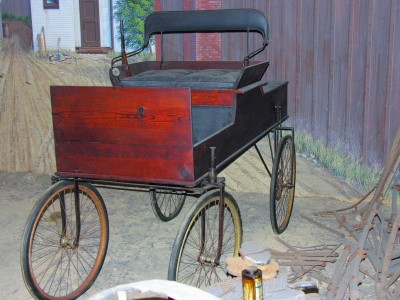
Petersen’s 3-D exhibit presents a Blacksmith Shop fronted by a filled horse trough with its hand pump. The dirt floor is littered with horseshoes. The hand-blown forge is ready to go.
The shop is surrounded with mural barns and sheds with actual wagon wheels and hand tools. Only the 1897 Anthony car looks out of place. Just as it did when it was new. (We heard a museum visitor telling her small son, “A horse used to pull it” To this day, people do not expect to find an electric motor under the seat.
I had the rare privilege of walking into this picture. The museum Docents and Security stood by for several moments as the
alarms sounded and I almost touched the past. One young Docent, her eyes round with worry, stood at my
side, not really trusting me! I
could see why: parts of the car
seat are actually hanging by a thread.
This re-build of the ECA car was done by 1954 for the celebration of 50 years of Anthony’s Packard dealership. ECA was 74 years old and the crashed car had rested in a tangled heap for 57 years! (except for the motor, which was rebuilt in 1903.)
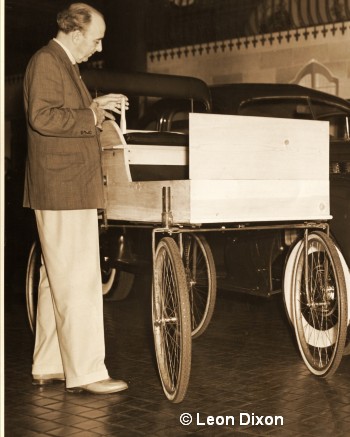
Earle C. Anthony inspecting the rebuilt
Although I worked for and spoke with Mr. Anthony: and often visited at 141 Vermont, Buena Park and 10th and Hope locations, I never, until now saw the restored car or heard about it being made or displayed.
And now, it is 51 years later. I hear,” Don’t climb into the seat. Don’t rock the car, and begging, Please don’t touch the car, it is on loan..”
Museum visitors crowded the exhibit. Hearing the sounding alarm of course and seeing the very old man in with the very old car. Both old enough to have visited the blacksmith shop when it was in operation, when horses drank from the trough and the Smithy quenched red hot metal in the water. (Few realized that he was remembering the sizzle, the odor of horses and the ringing sound of a pounding hammer on hot iron on iron.
With the exception of the spindly forks, now replaced, most of the original metal is in place again. Its fixed dimensions preserve the accuracy of this car’s appearance.
There is no indication that ECA ever rebuilt his car or assembled another. However, he and his father drove and sold electric cars with steel axels, smaller wheels and larger tires, better brakes and ‘modern’ steering.
Mr. Anthony saw the rebuilt car, what did he think of it? Why did they choose his failed project as a celebration logo?
For us, ECA’s electric car is a success. It marks the beginning of an adult life, for a large part, to be made up of Packard Motor cars and Radio Stations KFI and his namesake, KECA. This picture of his old car with the young man on board is appropriate for ECA’s 70th birthday celebration. The recording contains the voices of his old Executive staff, wishing him well.
Mr. Anthony had then made his KFI a 50,000-watt station. After World War II, I would be one of his KFI engineers at this same old RCA 50B transmitter. This story is now over 50 years old.
This old Electric Runabout was the first of thousands of motorcars that would crowd Mr. Anthony’s eventful life ………………. a life that included me.
100 YEARS LATER
This first car was short lived. Perhaps, assembling the car had totaled more hours than those ever spent, quietly rolling down the road. This electric car was too early for the road. It is a forerunner of the electric cars that are now poised to challenge the Gasoline Engine.
Soon to come, there can be, similarly powered, autos with no exhaust pipe or emitted fumes, no muffler needed for the quiet motor, no coolant for the radiator, no oil for the crankcase and furnished with four-wheel drive without differentials, universal joints and drive shafts.
Thanks to Marvin Collins, Stanley Kelton, Museum Curator, Mr. Kendall and his Curatorial assistant, Alex Symcox, for the hospitality that provided the special photo session with ECA’s home made Electric Motor / Dynamo.
Earle C. Anthony had received a classified letter from
the US AAF requesting him to operate KFI at 50,000-watts, twenty-four hours a
day. This ‘request’ amounted to an order.
Why was KFI on the air all night
without a sponsored program?
Why wasn’t KFI upgrading its
ancient transmitter and its old fashioned flat top antenna?
Why was KFI “wasting” its
signal over the ocean, where there were so few listeners?
Why was KFI property patrolled by
armed, US Army Riflemen?
Why were there several, 30-06
Springfield rifles with live ammunition kept in the KFI tube-locker?
Why were there searchlights on the
roof and vicious guard dogs on the loose?
Why was a brick enclosure ’layed
up’ around the KFI power sub-station?
Why did Earle C. Anthony wait until
1947 to erect his 750-foot KFI tower?
Why did we fly the American Flag
from dawn to dusk?
Why was the KFI transmitter and its
associated equipment being maintained at a level above commercial standards?
Mr. Anthony read words to this effect: “ The US Army Air Force (This was before we had a separate Air Force) will be using the radio signals of KFI 640, Los Angles and KPO, 680, San Francisco to guide our new military airplanes to Hawaii. Our navigators will be manning the airborne Direction Finding Devises” (Instead of beaming onto these beacons, they would develop their heading by tri-angulations. These planes used outboard, rotatable, circular, loop antennae (one can see them in these pictures, on top of the plane’s body between the wing and tail.)
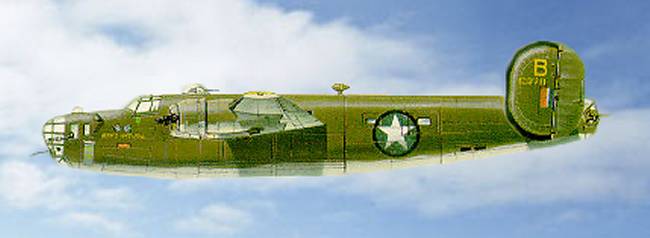
The radio-man/navigator developed azimuth by ‘tuning in’ a peaked signal from each station. He did this repeatedly as the plane moved outbound on its Hawaiian heading. He did this by sampling the overlapping signals from these two stations. Obviously, it was of extreme importance that these signals be uninterrupted, reliable and that they both radiate all the way to Hawaii. (RADAR was not a spoken word. It was called ’Electronics’.)
Each plane aloft required several squads of Airmen on the ground. This included the secret Ground Radar Branch. They wore a special pin on the Garrison cap.
While I was in my Air Force uniform, it bore the Latin
insignia; “Sustineo Alas” (translated as---“ I Sustain the
Wings” or "Keep 'Em Flying” or “I’ll Forever Hold Your Wings
High”). When I was discharged, “At the convenience of the Government,” I
came home to KFI and Earle C. Anthony. Secretly, we all had been supporting
the Air Force Wings!
KFI elected to remain on the air 24 hours a day, but
reduced power to 5,000-watts while erecting a new tower.
The big transmitter is now remotely controlled and the American flag, lowered for the last time, was folded and given to me.
53 years later, a private plane accidentally knocked this
tower down in a moment.
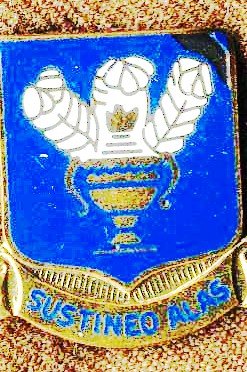
| We wish to express our thanks to Newcomb Weisenberger for
sharing his memories and pictures with us. Long retired from KFI, |
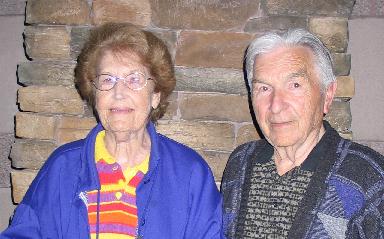 |